RANITAR, Nepal
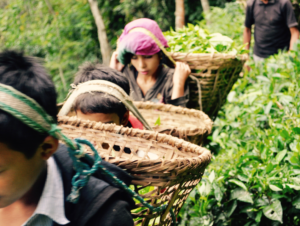
Tea was a gift fit for their king that the humble people of Nepal have cherished since its arrival.
Long before marketers labeled it organic, Nepal tea was grown with care. It was always the province of smallholders clinging to the mountain side like the trees they nurtured. Tea developed naturally. Unlike India there were no grand schemes by British East India Trading Co. potentates who used teams of elephants to uproot thousands of hectares of jungle to plant tea. There are no massive plantations in Ilam. Growers rejected monoculture in favor of mixed planting, often on marginal land unsuitable for food crops. Artisans there produce leaf grade orthodox equal to the most famous teas in the world.
The first tea seeds were a gift in 1842 from the Chinese Emperor brought home by Prime Minister Junga Bahadur Rana, founder of the 100-year Rana Dynasty. Ilam Tea Estate was planted in 1863 and Soktim TE in 1865. The first factory, built in Ilam in 1878, served the two estates and small gardens planted by Col. Gajaraj Singh Thapa in the 1860s. Almost a hundred years passed before the first large-scale plantation was established at Bhudhakaran in 1959.
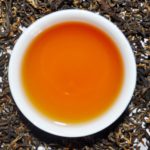 In modern times the application of fertilizer and pesticides and cut, tear, curl factories reduced Nepal tea to a commodity. The pursuit of quantity supplanted quality. Today there are approximately 26,165 hectares under tea of which 53% is managed by large tea estates. Production has nearly tripled from 8 million kilos in 2002. Black CTC teas account for 78% of total production, down from 80%. In 2015 Nepal produced 4,923 metric tons of orthodox, a sign the pendulum is swinging back to a time when artisan tea makers first mastered a hybrid of British orthodox and Chinese tea production techniques. The result is a delicate, bright and brisk, aromatic, tippy black tea with favors of baked fruit and a long finish. Greens and white teas are intensely floral.
In modern times the application of fertilizer and pesticides and cut, tear, curl factories reduced Nepal tea to a commodity. The pursuit of quantity supplanted quality. Today there are approximately 26,165 hectares under tea of which 53% is managed by large tea estates. Production has nearly tripled from 8 million kilos in 2002. Black CTC teas account for 78% of total production, down from 80%. In 2015 Nepal produced 4,923 metric tons of orthodox, a sign the pendulum is swinging back to a time when artisan tea makers first mastered a hybrid of British orthodox and Chinese tea production techniques. The result is a delicate, bright and brisk, aromatic, tippy black tea with favors of baked fruit and a long finish. Greens and white teas are intensely floral.
Challenging logistics
Landlocked with rivers too wild for commerce, there are no passable roads that run the 880 kilometer length of the country and few span Nepal’s 240 km width. Valleys there rise from 60 meters to jagged peaks 8,848 meters above sea level. Temperatures drop an average of 6-degrees Celsius for every 1,000 meters altitude and mimic the arctic above 4,400 meters. Railways are short and mainly traverse the sloping, marshy lowlands known as the Terai that borders northern India and comprises 17% of the country’s land mass.
Tea is the nation’s third most valuable agriculture export. Trade with India dominates, accounting for almost 90% of volume. The excellent teas of Nepal are underappreciated and priced low, representing only 2.4% of the country’s $1.6 billion export value. Prices vary by grade, ranging from NRs12 to NRs22 (US$0.11 to $0.20 cents) per kilo for green leaf. Trade with the United States represents 10% of foreign dollars earned by Nepal but very little of that is from tea. Germany is a significant partner in the tea trade, importing 2.8% of the tea bought outside the country. The Czech Republic, Kazakhstan, Australia, Canada, and France also send buyers to Nepal, principally for high-mountain loose leaf teas.
Production continues to increase but the amount of tea sold is declining. Exports dropped 1% in the seasonal year ending May 2016 despite significant growth in plantation area and volume. Export revenue declined to NRs2 billion (US$18.7 million) in 2015, according to the National Tea and Coffee Development Board. A crisis looms as India and Nepal engage in renegotiating a trade agreement in which India seeks to restrict and possibly prohibit the import of Nepal’s orthodox tea. Nepal produced 23.2 million kilos of tea last year, which was mostly sold to Indian blenders, several of whom now operate factories in Nepal. In many instances Indians serve as middlemen. Orthodox (loose leaf) represents about 21% of total production, totaling 4.9 million kilos, but no one knows exactly how much of the tea exported is specialty grade, since Nepal tracks only exports of CTC. Due to its premium price only 4% of Nepal’s specialty teas are sold in the domestic market and most of that is purchased by tourists.
Back to its organic roots
Tea flourishes in eastern Nepal at elevations of 6,000-feet (1,200 meters) near Ilam, Panchthar, Sindhupalchok, and Dhankuta. The larger gardens are in the lowlands of Jhapa district and the Terai. Jhapa produced 17.8 million kilos in 2013-14, about 84% of the country’s tea. Ilam produced 2.6 million kilos or about 12% of the total that same year. There are 142 tea estates employing 70,000 tea workers in the country of 26 million. Another 11,900 smallholders bring their hand-plucked teas to 54 bought leaf and estate-owned factories. Twenty of these factories produce orthodox tea.
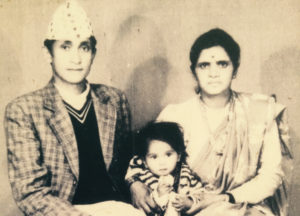
Kanchanjangha Tea Estate is the first garden in the country to achieve organic certification by the Institute for Marketecology (IMO). Additional certifications include NASAA (National Association of Sustainable Agriculture, Australia), JAS (Japanese Agricultural Standards) and USDA NOP (National Organic Program). Production averages about 60 metric tons per year of the 200 metric tons of organic grown in Nepal. The garden is in the shadow of Mt. Kanchenjunga, the world’s third highest peak. It has operated 32 years, markets its Nepal Tea LLC brand internationally and supports a tea research center. It is the only Fair Trade Certified (FLO) garden in Nepal, employing 600 farmers (200 directly and 400 indirectly). Those living on the original 94 hectares who organized the farmer-owned KTE co-op are provided with housing and a free education. Workers also receive daily necessities such as oil, rice, and salt at a subsidized rate through the co-op.
Since 1984 another 175 hectares of property farmed by smallholders has been certified organic.
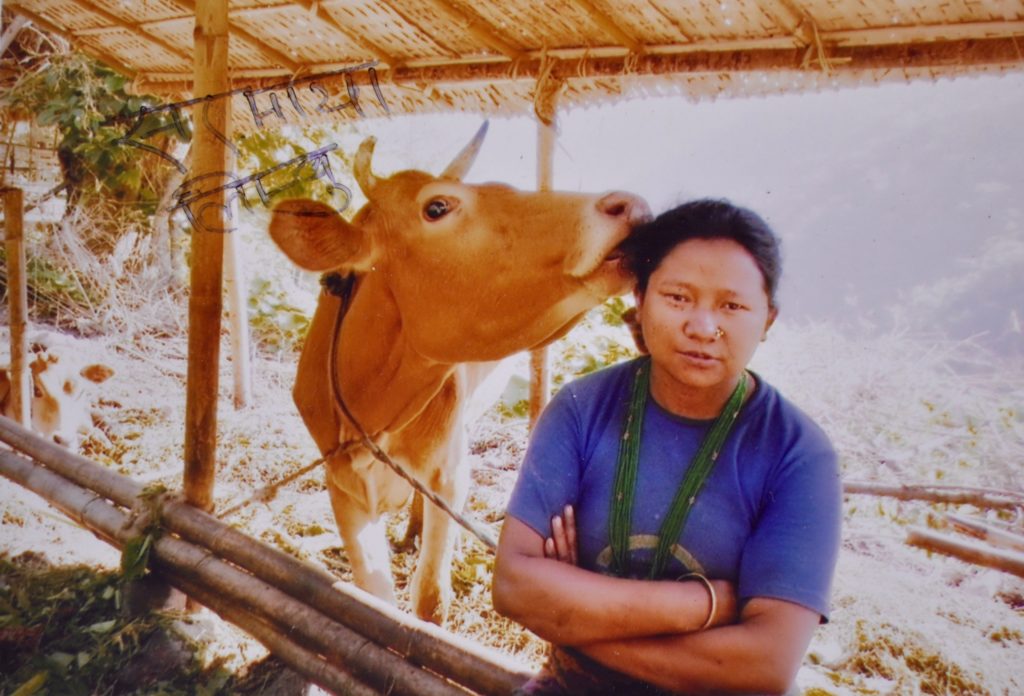 Ram Bahadur Gurung
Ram Bahadur Gurung
Ram Bahadur Gurung plucks tea at the garden, following in the footsteps of his mother and father who have worked at Kanchanjangha the past 27 years.
“I speak for my whole family when I say we are very fortunate and satisfied to have been a part of KTE,” writes Gurung, notes with pride that his family has raised three cows from the cow they were given by the estate. The “cow bank” began with the help of the Rotary Club USA, which donated 36 cows to the families. Dung is returned to the garden to use as fertilizer and the first calf is presented to another family. “It helps with our household income,” he said, grateful for the milk and cheese and meat that benefit the family over time. Workers living on the estate have access to clean and safe drinking water, electricity, and a smokeless oven which has positively influenced the health of workers and the villagers.
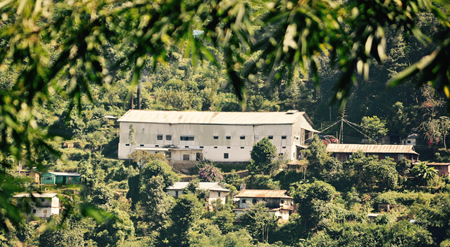
Nishchal Banskota is the 24-year-old son of Kanchanjangha Tea Estate founder Deepak Prakash Baskota. In February Nishchal launched a successful Kickstarter campaign to finance the brand’s “farmer-first approach that enables us to impact hundreds of families.” Children in Nepal do not receive a free education. One-in-four live in poverty and only 57% of adults can read and write. Banskota said a portion of sales are donated to a scholarship fund that has educated 2,300 students since 2002. A Japanese buyer pays tuition for 96 children at the Community School and local English Boarding School.
Banskota attended college in New Hampshire and set up a U.S. office in New Jersey after graduating last May. His company, Nepal Tea, intends to open the first Nepalese tea tasting room in the U.S.
“Nepalese teas, though they are as valuable as Darjeelings, have not found their identity yet,” he explains. “I am here to establish that identity and take it to the next level,” said Banskota. “For years Nepalese tea was rebranded and sold wholesale due to lack of developed infrastructure and middlemen traders making tea growing tough going,” he said. KTE trains its managers for a year after which they must pass a test to become junior supervisors.
Rita Baskota is the first and only female and the youngest supervisor at the tea garden. “Though I am very small, I am very confident in supervising the older tea pluckers. One of the main reasons that I joined the tea business at KTE is because I want to educate my little brother,” she said.
“I had the opportunity to get educated and since my family cannot afford a good schooling, I have taken the initiative to work and get my brother educated as a benefit from the company.
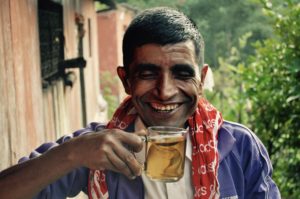
Backyard beginnings
He was only 15 when Deepak Prakash Baskota first saw the thousands of hectares of tea gardens that blanket the foothills of India’s Darjeeling tea growing region. On his return to the village of Phidin, he shared his vision of planting a tea garden and one-day building a tea factory near Ranitar in the remote hilly region of Panchthar district. In 1954 growing tea was a new concept and the villagers questioned his ambitions.
In response he decided to dive head-first into the project at first reading, and then exploring the nearby terrain to find if it would be suitable for tea. Ranitar is 50 kilometers north of tea-rich Ilam but the only way to know for certain was to conduct soil tests. He learned that the nearest soil laboratory was in Siliguri, West Bengal and so he walked there carrying two heavy sacks of soil 167 kilometers. The trip took three days. He discovered later that a handful of soil would have been sufficient.
Encouraged by the positive results but unable to purchase land, he and his wife, Dambar, planted the first trees in their backyard. Then, as the trees matured during the next four years, he visited Darjeeling as often as possible to learn how to make tea.
Gradually villagers began to grasp the potential and offered adjacent land for expansion until there was more than 200 acres and eventually enough leaf to require a factory which was completed in 1984.
Ratna Rai, now retired, was the estate’s first employee. “I am 70 now but I still work here because being at the factory makes me happy. I have seen the company grow from a handful of people to hundreds. I begin my day by gathering firewood and maintaining the fire for the drying machine. This has been my job for the past 32 years I am still not tired of doing it,” he said.
Buy direct
 In the U.S. Nepal Tea LLC joins a few other Nepal-friendly wholesalers who buy direct to not only shorten the long chain of middlemen, but also provide the freshest teas to consumers. The lack of cost-effective shipping is a significant barrier that encourages cooperation in the highly competitive tea sector. Their bond is a mutual concern for the people of Nepal, according to Jeni Dodd, CEO and founder of Jeni’s Tea in New York and Colorado-based Nepali Tea Traders, owned by Maggie Le Beau. Dodd has an apartment in Kathmandu and spends a lot of time with tea farmers. Le Beau, who sources her tea at KTE and Sandakphu TE, another Nepal co-op, is a champion of social entrepreneurship that helps a wider swathe of Nepali people. She believes that reinvesting in education and financing healthcare needs, will lead to a tea economy in Nepal valued at hundreds of millions of dollars.
In the U.S. Nepal Tea LLC joins a few other Nepal-friendly wholesalers who buy direct to not only shorten the long chain of middlemen, but also provide the freshest teas to consumers. The lack of cost-effective shipping is a significant barrier that encourages cooperation in the highly competitive tea sector. Their bond is a mutual concern for the people of Nepal, according to Jeni Dodd, CEO and founder of Jeni’s Tea in New York and Colorado-based Nepali Tea Traders, owned by Maggie Le Beau. Dodd has an apartment in Kathmandu and spends a lot of time with tea farmers. Le Beau, who sources her tea at KTE and Sandakphu TE, another Nepal co-op, is a champion of social entrepreneurship that helps a wider swathe of Nepali people. She believes that reinvesting in education and financing healthcare needs, will lead to a tea economy in Nepal valued at hundreds of millions of dollars.
“As a team, we’re helping to stimulate demand for Nepalese tea and create interest, and our aim is to push that number to over a billion dollars in the coming years,” she said.
Global demand for organic tea is growing and expected to increase and the local market is yet to be explored thoroughly, says Nishchal Bansoka, who advocates a shift toward quality production that will boost Nepal’s economy at the local and national level.
“We must transition into a greener and more efficient agricultural model demanded by our present day socio-economical and ecological realities,” he says.
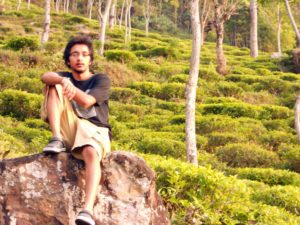
The social-business model works well in achieving these goals, says Bansoka, who is using Kickstarter donations to replicate the success at KTE at other tea farms, an important step in establishing sustainable communities throughout Nepal.
Research by Nikesh Dahal and Sudeshana Karki in Nepal. Photos courtesy Kanchanjangha Tea Estate.
Next read: Purnima Rai’s Tea Garden
Tea Market
Get More Value from Your Tea: BRU Maker One
+41794574278
Jacque's Organics
(647) 804-7263